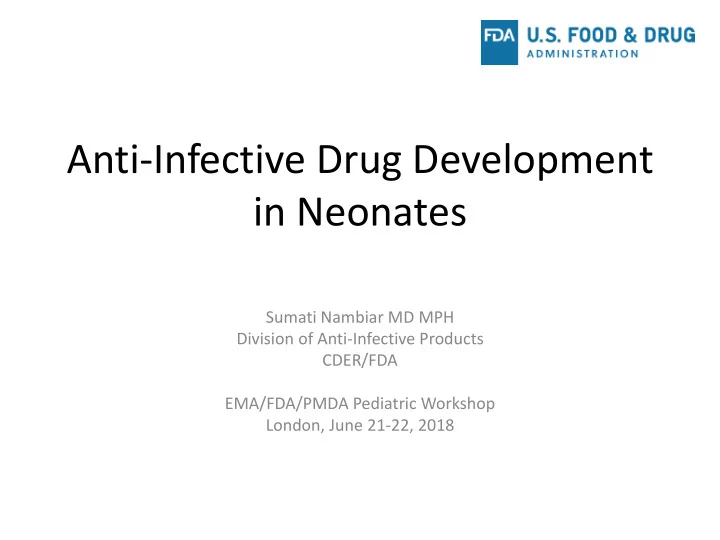

Anti-Infective Drug Development in Neonates Sumati Nambiar MD MPH Division of Anti-Infective Products CDER/FDA EMA/FDA/PMDA Pediatric Workshop London, June 21-22, 2018
Neonatal Studies • Of the anti-infective drug approvals since 2000, linezolid is the only drug product that has dosing information for neonates in labeling • Meropenem labeling was updated in 2014; studies done in accordance with the Public Health Service Act • We acknowledge the difficulties in studying neonates; single- dose pharmacokinetic (PK) studies seems to be feasible • Earlier approvals required a separate study for neonates; more recently, for many commonly studied indications, we have been asking for the entire pediatric age group (0-18 years) to be included in the same study 2
PREA Requirements: Antibacterial Drugs Drug Approval Pediatric Neonatal Year Indication/Dosing Indication /Dosing Linezolid 2000 From birth Variable [CSF] Ertapenem 2001 3 mo. and older No data. [CSF] concern Daptomycin 2003 Avoid use < 12 mo, neuromuscular effects dogs Telithromycin 2004 Peds trials halted- hepatic adverse rxns adults Tigecycline 2005 Peds trials not conducted – mortality risk adults Doripenem 2007 S/E in pediatric patients not established. Telavancin 2009 S/E in pediatric patients not established. Ceftaroline 2010 2 mo. and older Fidaxomicin 2011 S/E in pediatric patients not established. Dalbavancin, 2014-18 S/E in pediatric patients not established. Tedizolid, Oritavancin, Ceftolozane/tazobactam, Ceftazidime/ avibactam, delafloxacin, meropenem- 3 vaborbactam
PREA Requirements: Antifungal Drugs Drug Approval Pediatric Neonatal Year Indication/Dosing Indication /Dosing Caspofungin 2001 > 3 mo of age Not studied < 3 mo [CNS] not known Voriconazole 2002 > 12 yrs of age S/E not established Micafungin 2005 > 4 mo of age S/E not established Anidulafungin 2006 S/E not established < S/E not established 16 yrs of age. Posaconazole 2006 (oral > 13 yrs of age S/E not established susp) delayed release tabs 2013 (tab) and oral suspension 2014 (iv) 4
Substantial Evidence • Pediatric Research Equity Act (2003): for new drugs*, assessments of safety and effectiveness are required for all relevant pediatric subpopulations – Adequate and well-controlled studies – Extrapolation * new active ingredient, new indication, new dosage form, new dosing regimen, new route of administration 5
Extrapolation • Where the course of the disease and the effects of the drug are sufficiently similar in adults and pediatric patients, FDA may conclude that pediatric effectiveness can be extrapolated from adequate and well-controlled studies in adults usually supplemented with other information obtained in pediatric patients, such as pharmacokinetic studies. • Studies may not be needed in each pediatric age group, if data from one age group can be extrapolated to another . 21 CFR 314.55 6
Extrapolation Algorithm 7
Neonates • Difficult to extrapolate for all clinical conditions as pathophysiology and natural history of the disease in adult and pediatric populations and neonates may differ • Propensity for involvement of the CNS • Drug disposition may be different; might necessitate different dosing regimens • Heterogeneity in neonatal population based on gestational/postnatal age, birth weight • Safety considerations might be different- related to excipients/diluents, volume of drug products, concomitant medications 8
Extrapolation • Possible for – Acute bacterial skin and skin structure infections (ABSSSI) – Complicated urinary tract infections (cUTI) – Complicated intra-abdominal infections (cIAI) – Surgical necrotizing enterocolitis falls into this category; medical NEC requires further discussion (no adult correlate to permit extrapolation) – Hospital-acquired bacterial pneumonia/ventilator- associated bacterial pneumonia (HABP/VABP) • Not possible for – Invasive candidiasis 9
https://www.fda.gov/Drugs/NewsEvents/ucm507958.htm
Key Topics • Extrapolation to neonates – Clinical conditions in which extrapolating efficacy from adults and older pediatric population is acceptable for neonates – For indications where extrapolation is not feasible, how clinical efficacy can be demonstrated • Use of pediatric trial networks to obtain data in neonates • CSF penetration data: – Role of data from animal models of infection and areas of future research might facilitate anti-infective drug development – Role of in vitro models (such as hollow fiber models) and other tools – Role of using VP Shunt/other CSF sampling methods • Labeling: – In the absence of CSF penetration data, clinical utility of including dosing information 11
32 Invasive Candidiasis • Randomized controlled trial attempted with micafungin in neonatal candidiasis as efficacy cannot be extrapolated from adults • Changing epidemiology (lower incidence) made it difficult to enroll • Difficulty with a global study as standards of care changed • Difficulty in obtaining parental consent • Eligibility criteria increased the challenges in enrollment • Data requirements and efficacy definitions did not align with clinical management (e.g. 2 negative cultures to define eradication) Adapted from slides presented by Dr. Kovanda 12 https://www.fda.gov/Drugs/NewsEvents/ucm507958.htm
Research Project Bridging novel laboratory animal and hollow fiber infection models to evaluate CNS penetration of drugs in infants • Awarded to Duke University (HHSF223201610082C) • Objectives: – To develop and validate a rabbit model of CNS infection and define the pharmacodynamics of the antibacterial drugs meropenem and tobramycin for the treatment of meningitis – To develop and validate a hollow fiber infection model (HFIM) of neonatal meningitis to characterize the pharmacodynamics of meropenem and tobramycin by evaluating bacterial killing and emergence of antimicrobial resistance – To bridge the preclinical results to infants using population PK-PD modeling to guide dosing regimens of meropenem and tobramycin for treatment of meningitis in infants 13 https://www.fda.gov/downloads/AboutFDA/CentersOffices/OfficeofMedicalProductsandTobacco/CDER/UCM568991.pdf
Summary • Neonatal labeling for anti-infective drugs approved since the enactment of PREA is very limited • Important to have adequate information for safe use in this vulnerable patient population • There is a recognition that there are limitations in obtaining data to support safety and efficacy in neonates • Need to identify priorities to facilitate neonatal anti-infective drug development • Neonatal studies supported through the NIH BPCA program have played an important role obtaining information for drugs used most frequently in neonates – Challenges, successes, and lessons learned 14
Thanks
Recommend
More recommend